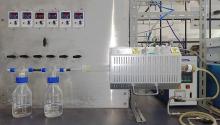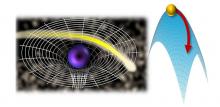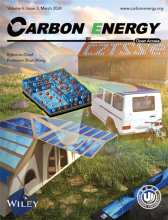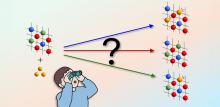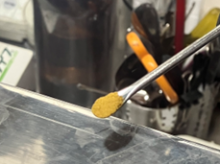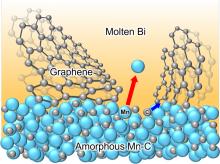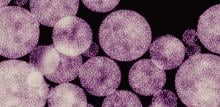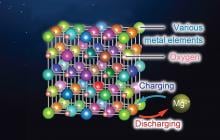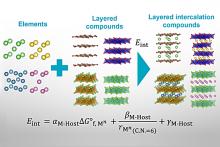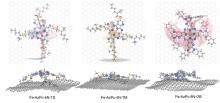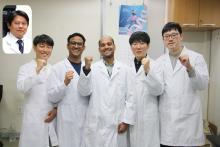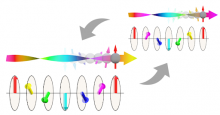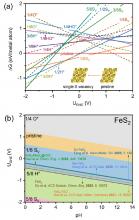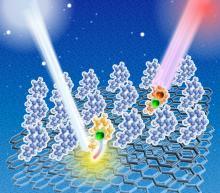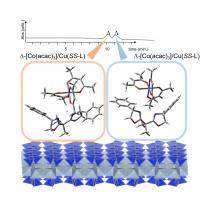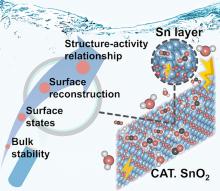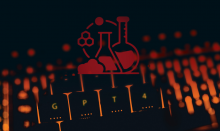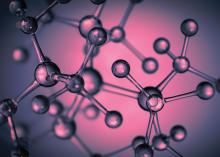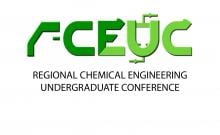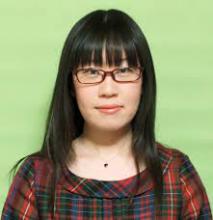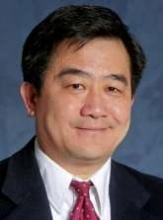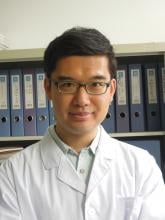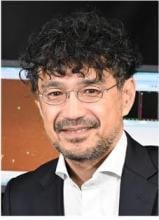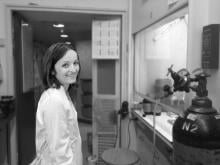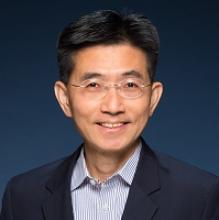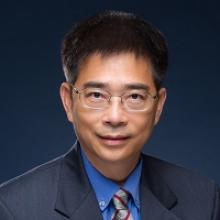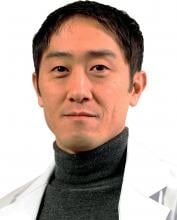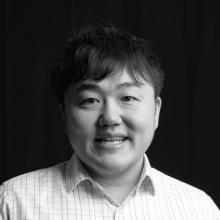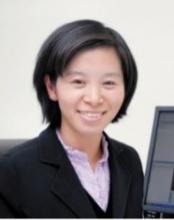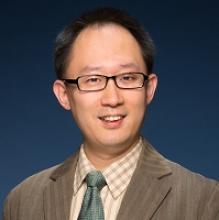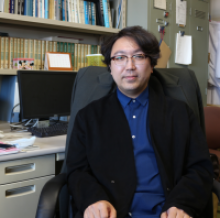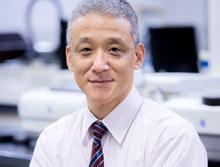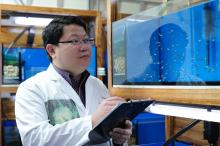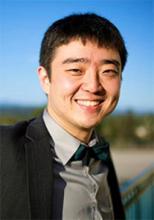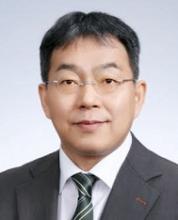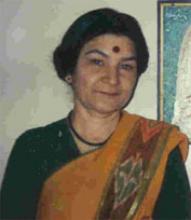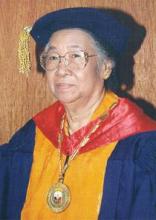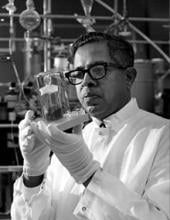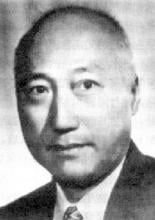Chemistry
News
23 Apr 2024
Researchers at Tohoku University and the Japan Atomic Energy Agency have discovered a unique property, the quantum metric, within magnetic materials, altering the 'electron universe' geometry. This distinct electric signal challenges traditional electrical conduction and could revolutionize spintronic devices.
22 Apr 2024
- A joint research team from DGIST-UNIST has developed ultra-high-efficiency pure red light-emitting devices by modifying the surface of perovskite light-emitting layers to enhance stability and electrical properties.
- The findings have been published in the journal “Materials Today.”
22 Apr 2024
- A joint research team between DGIST, Ewha Womans University, Incheon National University, and Sang-hoon Nam at MIT used atomic force microscopy to identify what causes electron-hole separation due to energy-level differences within and at the interface between crystals in the light-absorbing layer of thin-film solar cells
- Suggested directions to understand carrier behaviors in a variety of fields with atomic force microscopy
19 Apr 2024
Tohoku University researchers have unveiled a new means of predicting how to synthesize new materials via the ion-exchange. Based on computer simulations, the method significantly reduces the time and energy required to explore for inorganic materials.
12 Apr 2024
Zika virus vaccine targets brain cancer, 120-year quest to farm lobsters, Arctic nightlife bursts with sound, Eating a robot, Molecular orientation is key & New treatment for ALS and dementia. Read all in the latest Editor's Choice.
10 Apr 2024
Process that can lead to mass synthesis yields solid sulfide electrolyte with world’s highest reported sodium ion conductivity and glass electrolyte
09 Apr 2024
Nanocellular graphene, a specialized form of the revolutionary material graphene, is coveted for its ability to improve the performance of electronic devices, energy devices and sensors. But its development has been stymied by cracks that appear during the manufacturing process. Now, researchers have discovered a means to achieve crack-free, robust NCG - something they successfully put to use in a sodium battery.
05 Apr 2024
Rapid, responsive, and readily-available antigen-antibody testing is crucial in the fight against infectious diseases, something driven home by the COVID-19 pandemic. To improve these tests, a Tohoku University research group has created a new method to form polymer particles that are adorned with gold nanoparticles.
03 Apr 2024
Researchers at Tohoku University have made a groundbreaking advancement in battery technology, developing a novel cathode material for rechargeable magnesium batteries that enables efficient charging and discharging even at low temperatures.
03 Apr 2024
Drawing inspiration from the way plants breathe, a group of researchers at Tohoku University has created a paper-based magnesium-air battery that can be used in GPS sensors or pulse oximeter sensors. Taking advantage of paper’s recyclability and lightweight nature, the engineered battery holds promise for a more environmentally friendly source of energy.
03 Apr 2024
Disease-causing E. coli among species labeled electrochemically using organic metallic nanohybrids
03 Apr 2024
Researchers from the Institute of Industrial Science, The University of Tokyo and collaborating partners have created guidelines for the design of intercalated materials, which will accelerate research on energy storage, electronics, and more
29 Mar 2024
The lipids in some herbal teas have been identified in detail for the first time, preparing the ground for investigating their contribution to the health benefits of the teas.
28 Mar 2024
Tohoku University researchers have created a reliable means of predicting the performance of a new and promising type of catalysts. Their breakthrough will speed up the development of efficient catalysts for both alkaline and acidic environments, thereby saving time and effort in future endeavors to create better fuel cells.
25 Mar 2024
AI is revolutionizing the way researchers seek to identify new materials, but it still has some shortcomings. Now, a team of researchers has navigated AI’s pitfalls to identify a thermoelectric material that boasts remarkable properties.
25 Mar 2024
- The new photocatalyst is capable of generating methane production 51 times greater compared to commercial TiO2 photocatalysts by improving the surface and electrical properties with amorphous In2TiO5/MoSe2 photocatalysts
- The research results were published in Chemical Engineering Journal, a prestigious international journal in the field of energy and environment.
24 Mar 2024
- Development of 'Inorganic-Organic Thermoelectric Composite' from Low-Temperature Inorganic Thermoelectric Materials and Conductive Polymers, Ensuring Efficiency and Flexibility
- Research findings published in ACS Applied Materials & Interfaces
22 Mar 2024
A team of researchers has proposed a new concept for magnet-based memory devices, which might revolutionize information storage devices owing to their potential for large-scale integration, non-volatility, and high durability.
22 Mar 2024
The means to synthesize ammonia from nitrogen and hydrogen gas has been around since the early 20th century. Despite its current widespread usage, it has significant environmental drawbacks. Now, researchers from Tohoku University have unveiled a new, environmentally friendly means of producing this widely used chemical.
21 Mar 2024
Cellulose, abundantly available from plant biomass, can be converted into molecules used to make a new class of recyclable polymers, to sustainably replace some plastics.
15 Mar 2024
Understanding electron behavior and surface structure of triphenylene thin film molecules deposited on graphite substrates under light irradiation
15 Mar 2024
A packing material has been developed for chromatographic resolution on the basis of a clay mineral. The material is an adduct of chiral Cu(II) complex and synthetic hectorite.
08 Mar 2024
In a new step towards combating climate change and transitioning to sustainable solutions, a group of researchers has developed a research paradigm that makes it easier to decipher the relationship between catalyst structures and their reactions.
05 Mar 2024
A novel method for studying genes in testicular cells of living animals could lead to breakthroughs in male contraception and fertility treatments.
28 Feb 2024
A new user-friendly tool helps researchers explore how gene activity is influenced by chemical modifications, providing insights into disease and paths to new treatments.
28 Feb 2024
Molecules that are induced by light to rotate bulky groups around central bonds could be developed into photo-activated bioactive systems, molecular switches, and more.
26 Feb 2024
GPT-4 shows promise as an aid to chemistry researchers, yet its limitations reveal the need for further improvements.
26 Feb 2024
Researchers have developed an AI-driven system that can design novel molecules with any desired properties and suggest methods to create them using readily available materials.
23 Feb 2024
A German aircraft flying out of Cairns is measuring the chemistry of the clouds above Australia and the Pacific.
Events
26 Oct 2022 to 28 Oct 2022
Asia Clean Energy Summit (ACES) is the region's leading summit and exhibition focusing on clean and renewable energy growth and adoption, technology, policy and finance supported by leading government agencies, research institutes and industry.
07 Nov 2022 to 09 Nov 2022
FCS2022 is jointly organized by eight major research institutes in Singapore and includes a line-up of internationally renowned cancer experts. The conference converges the latest cancer discoveries around the world and promises ground-breaking and innovative insights into cancer research.
17 Jan 2022 to 21 Jan 2022
World’s brightest minds converge at virtual summit to inspire young researchers and discuss key issues
12 Jan 2021 to 15 Jan 2021
Organised by the National Research Foundation – Prime Minister’s Office, Singapore, the ninth edition of the Global Young Scientists Summit (GYSS@one-north) will take place 12 to 15 January 2021 as a virtual event.
08 Sep 2020 to 09 Sep 2020
Connecting Industry with Academia.
14 Jan 2020 to 17 Jan 2020
Organised by the National Research Foundation (NRF) Singapore, the Global Young Scientists Summit (GYSS) brings together distinguished scientists, post-graduates and academics for four days of learning and mentoring from 14 to 17 January 2020.
29 Oct 2019 to 01 Nov 2019
The Singapore International Energy Week (SIEW) is an annual platform for energy professionals, policymakers and commentators to share best practices and solutions within the global energy space.
Researchers
Dr. Chong Li Choo is an accomplished academic, Associate Professor at Taylor's University, expert in food technology, and innovative product design. Award-winning researcher, director for Food Security & Nutrition Impact Lab, and impactful leader in the field.
Dr Fabien Grasset is a Research Director at the Centre national de la recherche scientifique (CNRS) and currently serving as Director of Research for Rennes Institute of Chemical Sciences (ISCR). His areas of expertise include materials chemistry, solid-state chemistry, nanotechnology, nanoparticles, optical coatings and thin films.
Dr Naoka Nagamura is senior researcher at the National Institute for Materials Science (NIMS) and visiting associate professor at Tokyo University of Science. She researches advanced materials, electrochemistry and photoemission spectroscopy.
Professor Alex Jen Kwan-yue is Chair Professor of Materials Science and Director of the Hong Kong Institute for Clean Energy at the City University of Hong Kong (CityU). His expertise includes the use of molecular engineering and self-assembly for hybrid materials.
Dr. Zheng Chen is an environmental chemist and associate professor at Xi'an Jiaotong-Liverpool University. His research interests include nutrient recycling from agricultural waste, soil contamination and remediation.
Dr. Akira Kakugo is an Associate Professor at Hokkaido University. He has researched biomolecular motors and swarming of active matters.
Dr. Hira Khalid is serving as Associate Professor at Forman Christian College University, Lahore, Pakistan. She is also a US Fulbright Fellow and a member of several prestigious scientific organizations, including the American Chemical Society (ACS), the Royal Society of Chemistry (RSC), the International Union of Pure and Applied Chemistry (IUPAC), the Organization for Women in Science for the Developing World (OWSD), and the Chemical Society of Pakistan (CSP).
Ricky Wong Man-shing is a Professor of the Chemistry Department at the Hong Kong Baptist University
Prof. Cai Zongwei is now the Chair Professor of Chemistry in the Department of Chemistry and Director of both State Key Laboratory of Environmental and Biological Analysis as well as Dioxin Laboratory, Hong Kong Baptist University.
Professor Shinya Maenosono leads his research group at Japan Advanced Institute of Science and Technology (JAIST). His research in JAIST has focused on two main areas of interest in the field of materials chemistry and nanotechnology. The first area involved wet chemical synthesis of semiconductor nanoparticles with controlled size, shape and composition for energy conversion device applications. The second area has focused on the synthesis and bioapplication development of monometallic and alloyed multimetallic nanoparticles.
Dr Michinao Hashimoto's research interest is on low-cost device fabrication and their application in point-of-care setting.
Lecturer in Forensic Chemistry field. Actively engaging in agricultural waste upcycling into nanatechnology products.
Eriko Kage-Nakadai is a professor at the Graduate School of Human Life Science of Osaka City University.
Hochun Lee is a professor at the Department of Energy Systems Engineering, Daegu Kyeongbuk Institute of Science & Technology (DGIST).
Prof. Ann Marie Chacko lead the translational efforts for a portfolio of in vivo PET, SPECT, CT and optical imaging agents that span key therapeutic areas including oncology, immunology, infectious disease and neurobiology.
Yoonhee Jang is a Professor at the Department of Energy Science and Engineering of Daegu Gyeongbuk Institute of Science and Technology, Korea
Dr. Ken is currently an assistant professor in the department of Chemistry at HKBU. His current research interests center on advanced analytical chemistry technologies, with particular emphasis on creating and applying novel instrumental analysis technologies based on microfluidics and materials engineering.
Prof. Muneyuki Matsuo is an Assistant Professor at the Department of Chemistry, School of Science / Program of Mathematical and Life Sciences, Graduate School of Integrated Sciences for Life, Hiroshima University
Prof. Ganesh Pandian Namasivayam's research goal is to create "Smart Genetic Switches" that precisely ON and OFF the genetic and epigenetic factor(s) of interest.
Dr Yuichi Ohya’s research fields are functional polymers and biomaterials, especially biodegradable polymers and drug delivery systems.
Prof. Kenneth Leung Mei Yee has published over 200 peer-reviewed articles which are principally related to marine ecology, pollution, ecotoxicology, environmental risk assessment and ecological restoration using eco-engineering.
Carla Portugal is currently an Assistant Researcher at LAQV-Requimte, NOVA.iD.FCT and is experienced in the development, implementation and monitoring of membrane based processes.
Mayuko Nakagawa is a biochemist at Earth-Life Science Institute (ELSI) based at the Tokyo Institute of Technology, Japan.
Tony Z. Jia is a researcher at Japan’s Earth-Life Science Institute (ELSI), based at the Tokyo Institute of Technology. His research focuses on astrobiology, prebiotic chemistry, and origins of life.
A Tenured Professor at the Institute of Space Technology (Pakistan), Dr. Shabbir is working on Polymer based Nanomaterials for water treatment, food safety, nano-drug delivery systems, solar cells and carbon dioxide capture.
I do research on dysmennorrhoea and gender-based violence. I am a pioneer in registered clinical trials on indigenous and Ayurveda medicines in Sri Lanka. I have approval for a herbal preparation, for COVID patients.
Professor Kazuaki Ishihara leads the laboratory of catalysis in organic synthesis at the Department of Molecular & Macromolecular Chemistry, Nagoya University, Japan.
Dr.Ms.Aruna Dhathathreyan is a professor and emeritus scientist at the Advanced Materials Lab, CSIR-Central Leather Research Institute, India.
Giants in history
Japanese chemist Takamine Jokichi (3 November 1854 – 22 July 1922) founded the Tokyo Artificial Fertilizer Company, where he isolated a starch-digesting enzyme (named takadiastase) from the fungus Aspergillus oryzae.
A pioneer of bio-organic chemistry, Darshan Ranganathan (4 June 1941 – 4 June 2001) is remembered for developing a protocol for synthesising imidazole, a compound used to make antifungal drugs and antibiotics. Widely considered India’s most prolific researcher in chemistry, she also published dozens of papers in renowned journals on protein folding, molecular design, chemical simulation of key biological processes, and the synthesis of functional hybrid peptides and nanotubes.
Known as Mr. Natural Rubber, chemist and researcher B. C. Shekhar (17 November 1929 – 6 September 2006) introduced a number of technical innovations that helped put Malaysia’s natural rubber industry on the world map.
The research of Filipino pharmaceutical chemist Luz Oliveros-Belardo (3 November 1906 – 12 December 1999) focussed on essential oils and other chemicals derived from native Philippine plants.
Japanese chemist Kenichi Fukui (4 October 1918 – 9 January 1998) was the first Asian scientist to be awarded the Nobel Prize in Chemistry. Together with Roald Hoffman, he received this honour in 1981 for his independent research into the mechanisms of chemical reactions.
Filipina chemist María Orosa (29 November 1892–13 February 1945) fought malnutrition and food insecurity in the Philippines by devising over 700 culinary creations including Soyalac, a nutrient rich drink made from soybeans, and Darak, rice cookies packed with Vitamin B1, which could prevent beriberi disease caused by Vitamin B1 deficiency. She was also a partisan of the guerrilla movement resisting Japanese occupation during World War II, and died after being struck by shrapnel while working in her laboratory during the Battle of Manila.
Eminent Filipina scientist and educator Clara Lim-Sylianco (18 August 1925 – 23 July 2013) is remembered for her extensive research on mutagens – often-carcinogenic agents that permanently alter genetic materials such as DNA – antimutagens and bioorganic mechanisms.
Filipino chemist and pharmacist Manuel A. Zamora (29 March 1870 – 9 July 1929) is best remembered for his discovery of the tiki-tiki formula to combat beriberi, a disease caused by Vitamin B1 deficiency.
The field of solid-state ionics originated in Europe, but Takehiko Takahashi of Nagoya University in Japan was the first to coin the term ‘solid ionics’ in 1967. ‘Solid-state ionics’ first appeared in 1971 in another of his papers, and was likely a play on ‘solid-state electronics’, another rapidly growing field at the time.
Indian organic chemist Asima Chatterjee (1917 to 2006) studied the medicinal properties of plant products, especially compounds known as vinca alkaloids.
Cyril Andrew Ponnamperuma (16 October 1923 – 20 December 1994) was a Sri Lankan chemist who was interested in the origins of life on Earth. His research in chemical evolution showed how inanimate molecules may have given rise to the building blocks of life – a process known as abiogenesis.
Chika Kuroda (24 March 1884 – 8 November 1968) was a Japanese chemist whose research focussed on the structures of natural pigments.
Osamu Shimomura (27 August 1928 – 19 October 2018) was a Japanese organic chemist and marine biologist who dedicated his career to understanding how organisms emitted light.
Kikunae Ikeda (8 October 1864 – 3 May 1936) was a Japanese chemist who discovered the fifth basic taste, umami.
Hsien Wu (24 November 1893 – 8 August 1959) is widely regarded as the founder of biochemistry and nutrition science in China. He was the first to propose that protein denaturation was caused by the unfolding of the protein, instead of chemical alteration.
Umetaro Suzuki (7 April 1874 – 20 September 1943) was a Japanese scientist best remembered for his research on beriberi, a disease caused by vitamin B1 deficiency, characterized by limb stiffness, paralysis and pain.
Salimuzzaman Siddiqui (19 October 1897 – 14 April 1994) was an artist and chemist from Pakistan whose research focused on natural products from plants.
Japanese geochemist Katsuko Saruhashi developed the first method and tools for measuring carbon dioxide in seawater


